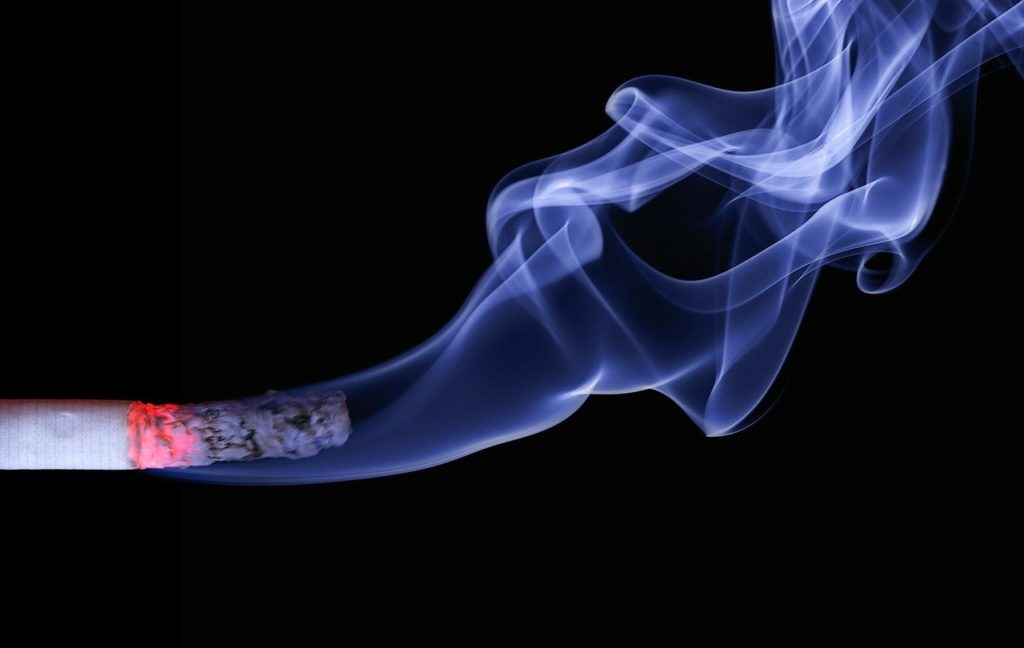The science behind smoking
by Scott Dutfield · 29/08/2020
How damaging can a single cigarette be?

Often believed to be a modern-day vice, smoking and chewing tobacco leaves have been habits humans have had for thousands of years. It wasn’t until the early 1500s that tobacco cultivation reached Europe, after Christopher Columbus discovered Native Americans smoking dried tobacco leaves. By the 1700s smoking became widespread, resulting in the rise of the tobacco industry. Although it’s been on a steady decline in recent years, in 2018 it was found that around 7.2 million people aged 18 and over smoked in the UK alone.
In 2017 the NHS found that 77,800 deaths were attributed to smoking, with a further 489,300 people admitted to hospital. As an efficient drug-delivery system, cigarettes are designed to facilitate the transport of addictive and dopamine-inducing chemicals such as nicotine into the smoker’s bloodstream. For example, the average smoker inhales between one to two milligrams of nicotine per cigarette. Nicotine is the driving force of smoking addiction, with smokers pursuing an apparently stress-relieving shot of dopamine. With the average person taking ten puffs on a cigarette before it’s burnt out, a single pack of 20 cigarettes will provide about 200 hits of nicotine.
Other than the addictive nature of nicotine, a single cigarette contains over 7,000 chemicals, of which at least 69 are known to cause cancer. One particularly destructive toxin is a residue called tar. Upon inhaling the smoke of burning tobacco, this brown sludge enters the lungs, coating the lining of the organ along with the walls of the trachea. Along these internal walls are tiny hair-like cells called cilia which are responsible for trapping pollutants and dust before they’re absorbed by the body. As the tar builds, these cellular bodyguards become paralysed and unable to repel any unwanted intruders, leaving the body at risk of infection and opening a gateway to a collection of toxic chemicals. As the tar continues to accumulate, a once-healthy pink lung eventually becomes grey or black.
As one of the hundreds of smoke-bound toxins that can enter the body, the potential damage this deadly cocktail can cause is vast. Smoking causes 84 per cent of deaths from lung cancer and 83 per cent of deaths from chronic obstructive pulmonary disease. But the lungs aren’t the only organ to be affected by smoking. In fact, nearly every aspect of the human body can be negatively impacted by smoking. From increasing blood pressure and greying skin to causing a stroke and infertility, as little as one cigarette a day is enough to increase a man’s risk of developing heart disease by 48 per cent, and a 25 per cent higher risk of having a stroke.
The root of the problem
Tobacco (Nicotiana tabacum), native to both North and South America, is now one of the most cultivated plants around the world. China is the leading producer of tobacco, farming almost 2.3 million tonnes of the plant in 2017. Between the farmland and fingertips, harvested tobacco goes through different methods of curing and drying to create the tea-like filler found in cigarettes. For example, one method used in Virginia is flue-curing tobacco. This involves hanging picked leaves inside a small enclosed barn, which is heated by burning different woods and charcoal and vented. Curing transforms the once-lush green leaves into shrivelled yellow-brown dried leaves in four to eight days, ready to be processed and placed into cigarettes.
Do cigarette filters work?
Before the 1950s cigarettes were smoked without the use of a barrier between leaf and lips. However, as concerns began to grow about the potentially damaging effects of lighting up, the production of cigarette filters began. Manufacturers promised spongy plastic cellulose-acetate filters were a way to remove the majority of smoke – and thus the dangerous tar and nicotine – from entering the body. This was believed to be due to the perforations within the filter allowing more air through and less smoke. However, once addicted the body craves a certain amount of nicotine: filters reduce the amount of nicotine inhaled, which means that smokers turn to light another cigarette until they can satisfy their craving.
This article was originally published in How It Works issue 136
For more science and technology articles, pick up the latest copy of How It Works from all good retailers or from our website now. If you have a tablet or smartphone, you can also download the digital version onto your iOS or Android device. To make sure you never miss an issue of How It Works magazine, subscribe today!




